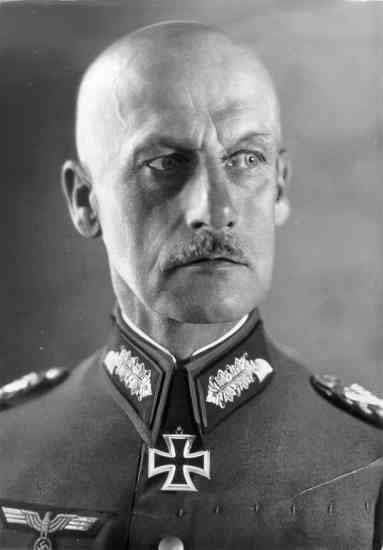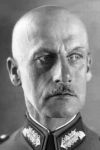Wilhelm Joseph Franz von Leeb was born September 5,1876 in Landsberg am Lech, the son of a Bavarian army officer. He was brought up in strict Roman-Catholic fashion which was to leave its marks during his later career. Considering the military tradition of the family, he was destined to become an officer and so it happened. At the age of 19, he joined 4. Feldartillerie König, a Bavarian unit in Augsburg, holding the rank of Fahnenjunker. Next came short detachments to the War Academy in Munich, the Bavarian School of Artillery and Engineers and the artillery factory in Amberg.
After China had declared war on various western powers, followed by the Boxer revolution, Von Leeb was called up to lead the Gebirgsbatterie des Ostasiatischen Feldartilleri-Regiment in the rank of platoon commander. The unit was part of the German detachment of a western force to quell the revolt in China in which it succeeded but the unit arrived too late to undergo its proper baptism of fire. Meanwhile rest had been restored but his unit did become involved in skirmishes against Chinese rebels during its short stay in China.
After his return to the German empire, Von Leeb took up study at the Kriegsakademie in Munich; he served at headquarters of the Bavarian General Staff from October 1907 to October 1909 and until September 1911 on the Great Prussian General Staff in Berlin. Next he was placed in command of a battery in 10. Bayerische Feldartillerie-Regiment with which he took part in World War One. In 1915, he was transferred to 11. Bayerische Infanterie-Divison serving as first officer on the general staff. This division was deployed at almost every front. Von Leeb accompanied his division in the fighting in Galicia, Serbia, Verdun, Romania, in the Alsace and in the Champagne region. In 1916, Von Leeb, meanwhile risen to major, was knighted, hence the addition Ritter to his name. Towards the end of the war, Von Leeb was pulled back from the front and was involved in studying the history of warfare with regard to the previous war years.
Von Leeb belonged to the conservative circle within the German army and became a member of a Freikorps after the humiliating armistice had been signed. The Freikorpse engaged Communist rebels in Germany itself, also in Bavaria where he was born. Owing to his excellent achievements, Von Leeb was almost automatically incorporated in the Reichswehr, the new army of the Weimar Republic which was limited to 100,000 men as stipulated by the Treaty of Versailles.
During his tenure in the Reichswehr, he managed to rise to the rank of Generalleutnant. Between 1919 and 1923, he was employed as department head and advisor at the Reichswehrministerium; as chief of staff of various Wehrkreise (military districts), including Stettin and Munich until he was appointed regimental commander in Artillerie-Regiment 7. In recognition of his outstanding work, he was given command of the Bayerische Division in Munich in 1930.
Von Leeb held this post until 1933. Then, Adolf Hitler managed to seize power in Germany. The conservative Roman Catholic Von Leeb adopted a skeptical attitude towards the Nazis from the beginning. In the Third Reich, the Reichswehr was incorporated in the newly established Wehrmacht with a special task being reserved for Von Leeb. He became commander of Gruppenkommndo 2 in Kassel and was promoted to General der Artillerie.
In that capacity, Wilhelm von Leeb developed a theory with regard to waging defensive battles. He had an opinion on defense quite his own, the so called elastic defense by deploying mobile units. In 1938, Von Leeb published his findings in his book Die Abwehr. The same year, Adolf Hitler shrewdly made use of the bogus affair, supreme commander of the German army, Werner Freiherr von Fritsch and Minister of War Werner von Blomberg fell victim to, to pull absolute power over the armed forces to himself. Subsequently he fired a considerable number of his generals or, in the case of Von Leeb, forced them into early retirement.
Contrary to all expectations, Von Leeb was recalled later that year. In October he commanded the Wehrmacht units during the annexation of the Sudetenland. For this achievement, he was promoted to Generaloberst a month later. In September 1939, Von Leeb was in charge of the Wehrmacht along the western borders of the Third Reich when Hitler’s troops invaded Poland in the east (Fall Weiss). Although Von Leeb was convinced he stood no chance against an attack by French troops due to the limited size of his forces, the French did not launch an attack. Both France and Great Britain declared war on Germany though.
After Poland had been overrun by the Germans, Hitler focused his attention on the West. The Germans began planning a campaign against France. Von Leeb was placed in command of Heeresgruppe C which occupied the Siegfried line, running from the Luxemburg border down to the border with Switzerland, right in front of the French Maginot line. On May 10, 1940, Fall Gelb was launched, the campaign against France, Belgium and the Netherlands followed by Fall Rot in which Heeresgruppe C was ordered to eliminate the Maginot line. Von Leeb managed to take the Maginot line, hitherto considered impregnable and sealed the fall of France. For this, Von Leeb was rewarded with a promotion to the highest rank, Generalfeldmarschall.
After the victory over France, Hitler turned his attention eastwards. During the campaign against Russia, code named Operation Barbarossa, a special role was reserved for Von Leeb. He was appointed commander of Heeresgruppe Nord, the most northerly of the three army groups that participated in the attack on Russia. Operation Barbarossa was launched on June 22, 1941 and contrary to all expectations, Heeresgruppe Nord made the most progress of all. The Baltic states were overrun and the Soviet northwest front was all but eliminated. After a month, the Germans managed to penetrate the Stalin line on the former Latvian-Russian border. The road to Leningrad lay wide open but the Soviets had re-inforcements move in but the grim and tenacious resistance by the Soviets, the long lines of supply, the shortage of men and the difficult terrain worked against Von Leeb. The German advance slowed down and Hitler transferred a Panzerkorps from Heeresgruppe Mitte to the north to force a break through to the city that bore Lenin’s name. The advance on Leningrad proceeded extremely fortunate but the Germans were stopped in the southern suburbs by new re-inforcements of the Red Army that consisted partly of civilian militias who offered fierce resistance. When it became clear the city could not be captured easily without severe losses on German side, Hitler decided to lay siege to the city to starve it into submission and ultimately obliterate it from the face of the earth. In September Hitler recalled his tanks for the offensive on Moscow, Operation Typhoon.
Heeresgruppe Nord almost did succeed in cutting off Leningrad from the outside world completely – only one connection was still possible across the frozen waters of Lake Ladoga in winter – but he failed to make contact with the Finnish forces on the right bank of the river Svir northeast of Leningrad commanded by Marshal Carl Mannerheim. Although the town of Tikhvin was captured in November 1941; by pulling back his armored forces Von Leeb was left with insufficient hitting power to carry the push through to the river Svir. The Red Army initially managed to slow down Von Leeb’s advance and then stop it. Von Leeb decided the situation of his troops was dangerous and he ordered a tactical withdrawal, shortening the frontline and so make it better defendable. When Hitler heard about this, a conflict erupted between the Führer and the field marshal. In contrast to other commanders who had failed, Von Leeb was not relieved of his function. In January 1942, he resigned as commander of Heeresgruppe Nord at his own request after his troops had been driven from the area around Tikhvin during the Russian winter offensive. Until the end of the war, the Feldmarschall was part of the Führerreserve of the O.K.H. and no longer played an active role in the army.
On May 2nd, 1945, Von Leeb was taken prisoner by American forces. In October 1948, he was to appear before the war tribunal in Nuremberg that sentenced him to three years imprisonment for having committed war crimes; by mistake as appeared later. This verdict was caused by documents having been interchanged. It was not revoked and because he had already spent three years in American custody, he was released after his sentencing.
Wilhelm Ritter von Leeb died April 29, 1956 in Hohenschwangau in the vicinity of Füssen.
Images
Information
- Article by:
- Tom Notten
- Translated by:
- Arnold Palthe
- Published on:
- 19-01-2025
- Feedback?
- Send it!
Sources
- Haupt, Werner. Heeresgruppe Nord: Der Kampf im Nordabschnitt der Ostfront 1941 – 45, Bad Nauheim: Podzun, 1966.
- Meyer, Georg (red.): Generalfeldmarschall Wilhelm Ritter von Leeb: Tagebuchaufzeichnungen und Lagebeurteilungen aus zwei Weltkriegen (Stuttgart: Deutsche Verlags-Anstalt, 1976)
- Mitcham jr, Samuel W: Hitler's Field Marshals and Their Battles, London: Leo Cooper, 1988











